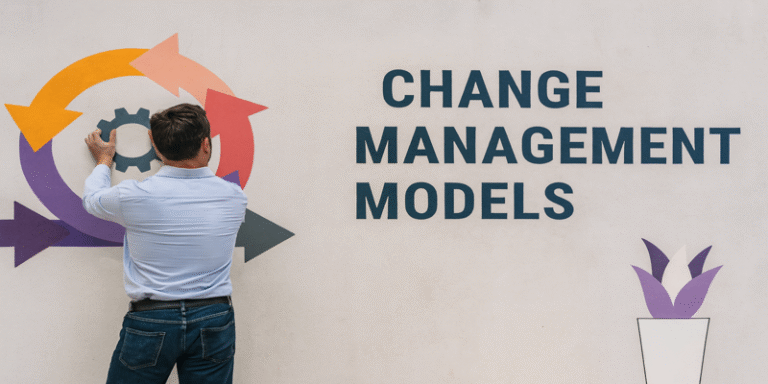Change management is a structured discipline concerned with preparing, supporting, and guiding individuals, teams, and organisations through transformation. As organisations face increasing technological disruption, global competition, and sustainability demands, adopting effective frameworks becomes essential (Cameron & Green, 2015). This article explores three widely recognised Change management models—Lewin’s Three-Step Model, Kotter’s 8-Step Process, and the ADKAR framework—and compares their applicability in achieving sustainable transformation.
Lewin’s Change Management Model
Introduced by Kurt Lewin (1951), this foundational model remains influential due to its simplicity. It consists of three stages:
- Unfreeze: Preparing stakeholders by breaking down the existing status quo. Leaders must communicate why change is necessary and overcome inertia. Burnes (2017) stresses that “unfreezing” requires destabilising current habits while creating a compelling vision of the future. For example, in the financial services industry, unfreezing has been critical when adopting regulatory reforms after crises.
- Change: Transitioning towards new practices. This stage requires training, communication, and leadership support. Employees often feel uncertain, making empathy and resources vital.
- Refreeze: Embedding new practices into organisational culture. Without this step, employees may revert to old behaviours. For instance, in healthcare, digital record adoption only succeeded once institutions reinforced new systems with ongoing training and leadership advocacy (Burnes, 2017).
Lewin’s model is best suited for structured environments requiring incremental transformation. However, critics argue it oversimplifies today’s continuous, non-linear changes (Memana, 2025).
Kotter’s 8-Step Process for Leading Change
John Kotter (1996) expanded Lewin’s work with a step-by-step framework for large-scale transformation. The steps are:
- Create a Sense of Urgency: Highlight risks of inaction.
- Form a Powerful Coalition: Assemble a team of influential leaders.
- Create a Vision for Change: Define a compelling direction.
- Communicate the Vision: Ensure clarity and repetition across levels.
- Remove Obstacles: Empower staff and eliminate structural barriers.
- Create Short-Term Wins: Demonstrate early progress to build momentum.
- Build on the Change: Consolidate gains and refine processes.
- Anchor Changes in Culture: Ensure long-term alignment with values.
Kotter’s model is particularly effective for complex transformations such as mergers, acquisitions, or sustainability initiatives. For example, Unilever’s Sustainable Living Plan applied Kotter’s principles, using urgency and cultural anchoring to embed environmental values.
Recent applications show its ongoing relevance. Yalçın (2025) highlights its use in digital transformation projects, where urgency, coalitions, and cultural embedding are crucial for achieving sustainable outcomes. However, critics note the model’s linearity may not reflect the iterative realities of modern change (Gaur & Bisht, 2025).
The ADKAR Model
Developed by Jeff Hiatt (2006), the ADKAR framework focuses on the individual experience of change. Its five components are:
- Awareness of the need for change.
- Desire to support the change.
- Knowledge of how to change.
- Ability to implement behaviours.
- Reinforcement to sustain outcomes.
ADKAR’s strength lies in its focus on personal adoption, recognising that organisational transformation only succeeds when individuals transition effectively. For example, in IT system rollouts, ADKAR has been used to diagnose why employees resist adoption and to tailor targeted interventions (Hiatt & Creasey, 2012).
Modern research supports its relevance. Memana (2025) notes that ADKAR aligns with ethical and participatory approaches, fostering employee engagement and sustainable results. Similarly, case studies in higher education demonstrate its value in aligning learning and cultural transformation.
Comparing the Models
While all three models provide valuable insights, they differ in scope and emphasis:
- Lewin’s model: Strength lies in its clarity and structure. However, it may oversimplify ongoing transformations in fast-moving industries.
- Kotter’s model: Provides a detailed roadmap with emphasis on leadership and momentum. Criticised for being too rigid in agile environments.
- ADKAR model: Excels at individual-level change, making it suitable for HR and digital training initiatives. Less suited to macro-level organisational strategy.
Scholars now argue for hybrid approaches. Gaur and Bisht (2025) propose combining Kotter’s urgency-building with ADKAR’s reinforcement to ensure both organisational momentum and individual adoption in sustainable technology adoption projects.
Challenges in Applying Models
Despite their strengths, applying change models presents challenges:
- Cultural barriers: Organisations with rigid hierarchies may resist participatory models such as ADKAR.
- Continuous disruption: Linear models like Lewin’s and Kotter’s may struggle to adapt to ongoing transformations.
- Leadership commitment: Without sponsorship, even the best frameworks fail. As Yalçın (2025) stresses, leadership vision is non-negotiable in digital and sustainability transitions.
Real-World Applications
- Healthcare: Hospitals applying ADKAR for electronic health record adoption achieved higher compliance when focusing on awareness and reinforcement.
- Technology: Microsoft’s transformation under Satya Nadella integrated Kotter’s urgency-building with cultural anchoring, enabling a growth mindset culture.
- Education: Universities applying Lewin’s model to curriculum reforms found “refreezing” challenging due to ongoing digital disruption, requiring iterative refinements (Memana, 2025).
Towards Sustainable Transformation
Sustainability has become a dominant theme in change management. Kotter’s urgency and cultural embedding are crucial for sustainability initiatives, while ADKAR ensures individual alignment with environmental goals. Yalçın (2025) shows how organisations adopting hybrid models can embed sustainability not just structurally, but behaviourally.
Change management models remain indispensable tools for navigating organisational transformation. Lewin’s model offers simplicity and clarity; Kotter’s framework delivers a structured roadmap; ADKAR focuses on individual journeys. However, sustainable transformation often requires a blended approach, combining urgency, structured leadership, and individual reinforcement.
As organisations face continuous digital and sustainability pressures, leaders must not treat these models as rigid formulas but as adaptive guides. By integrating classic and modern approaches, organisations can overcome resistance, engage stakeholders, and achieve transformations that are both effective and sustainable.
References
Burnes, B. (2017). Kurt Lewin and the Harwood studies: The foundations of OD. Journal of Change Management, 17(2), pp. 91–100.
Cameron, E. & Green, M. (2015). Making Sense of Change Management. 4th ed. Kogan Page.
Gaur, M.H. & Bisht, B. (2025). Strategic frameworks for successful technology adoption and change management. WAIMSC Proceedings. Available at: ResearchGate
Hiatt, J.M. (2006). ADKAR: A Model for Change in Business, Government, and our Community. Prosci Research.
Hiatt, J.M. & Creasey, T.J. (2012). Change Management: The People Side of Change. 2nd ed. Prosci Learning Center.
Kotter, J.P. (1996). Leading Change. Harvard Business School Press.
Lewin, K. (1951). Field Theory in Social Science. Harper & Row.
Memana, P. (2025). Leadership in education during transformation: Sustainable and participatory approaches. Journal of Educational Development Reviews.
Yalçın, C. (2025). Digital transformation and organisational change management: Theoretical models and case studies. ResearchGate.









